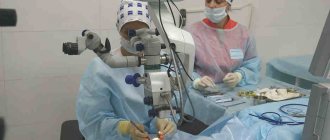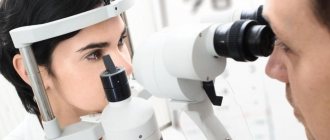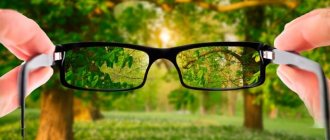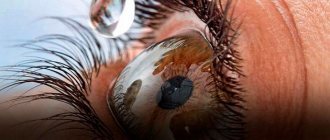Even if a person has ideal vision from birth and throughout his life, with age there may be a possibility of a sharp deterioration: problems arise and diseases develop for which there was no predisposition before. But modern ophthalmology has a number of methods that can improve vision in age-related farsightedness.
In this article
- About the features of the disease
- How can you improve your vision when you are farsighted after 40?
- Operation
- Medication method
- Glasses
- Lenses
- Optical products for correcting age-related farsightedness
Why does near vision deteriorate after 40?
Every person over 40 notices some changes in their vision. For example, the occurrence of a disease such as presbyopia - a gradual loss of focusing near vision. “Short arm disease” is what this disease is sometimes called, because when reading the small print of a newspaper, many people have to move the magazine away. It develops at the age of 40 years. It is then, while reading or sewing, that a person begins to feel discomfort. Unfortunately, it is impossible to avoid this disease. Even someone who has had excellent vision throughout their life will become presbyopic.
Symptoms may include:
- Blurriness while working at the computer, reading, etc.;
- Headache (because you constantly have to strain your eyes trying to see something);
- Tired eyes;
- Bad feeling.
What causes presbyopia?
First of all, these are age-related processes, as well as loss of elasticity of the lens. It can change shape while focusing at close range.
Age-related farsightedness
With age, accommodation—the focusing ability of the eyes—deteriorates. So-called presbyopia develops - age-related farsightedness. As a result of sclerotic changes, the lens cannot maximize its curvature, the refractive power decreases - the person begins to see worse up close.
Moving a book or newspaper away from your eyes is an attempt to compensate for the lack of accommodation. But there comes a time when it is no longer possible to do without glasses. With normal eye refraction, presbyopia begins at 40-45 years of age, but in nearsighted people it develops later, and in farsighted people - earlier.
How to improve vision at 40 years old?
Going to the pharmacy and purchasing reading glasses is the best way to slow down this disease. The myth is that nearsighted people become farsighted in old age.
Some people believe that with age, people diagnosed with myopia become farsighted. So, this is not true. Most people who develop myopia at an early age experience complications. Almost 80% begin to have problems with the retina. Everyone knows that during myopia after 40 years, the eyeball enlarges, and the retina stretches accordingly. Therefore, as soon as you find out that you have myopia, about once a year it is necessary to diagnose the fundus of the eye. If a retinal tear is detected, laser coagulation is performed. Laser coagulation is a correction method that allows you to promptly stop degenerative and dystrophic processes in the retina.
It is important! If vision is no more than 3 diopters, there is a possibility that a refractive shift towards farsightedness will occur. If it is more than 6 diopters, then there are no signs of farsightedness and there will not be any.
How to help your eyes?
In the first place, of course, will be a healthy lifestyle. How to preserve vision? To do this you need:
- Eat properly;
- Take care of your eyes;
- Stop smoking;
- Visit an ophthalmologist regularly to identify any diseases at an early stage;
- It is necessary to take vitamins for the eyes after 40 years;
With proper nutrition, it is necessary to take into account that it must be balanced. Products containing vitamins B, A and C improve blood circulation, strengthen the walls of blood vessels and normalize intraocular pressure. Vitamin A is found in beef liver and egg whites. Carrots, blueberries and vegetable oil contain carotene. Meat and dairy products, as well as bananas, cabbage and buckwheat, contain B vitamins. The well-known vitamin “C” is found in fruits, rose hips, herbs and vegetables. Arguing about what causes vision loss after 40 years, we can conclude that the main enemies are: age and lifestyle.
It is important! Foods that contain too many carbohydrates lead to vision degeneration.
Treatment of age-related eye diseases
Treatment tactics for age-related eye diseases depend on many factors. But most often complex therapy is used. Drug therapy is used in the preoperative and postoperative period.
Drugs that may be prescribed:
- medications to normalize intraocular pressure (especially relevant for glaucoma);
- eye drops that improve metabolic processes in the lens (necessary for cataracts);
- drugs that improve blood circulation, angioprotectors, steroids, anticoagulants (necessary for diabetic retinopathy), etc.
The basis of treatment of ophthalmological diseases associated with age-related changes is surgery. For different diseases, the most effective and relevant type of surgical procedure is chosen:
- For glaucoma, the following may be prescribed: canaloplasty, laser or surgical iridectomy, endoscopic cyclophotocoagulation, cryotherapy of the ciliary body, etc.
- For cataracts, phacoemulsification is considered the most effective. This procedure is relatively safe and practically does not provoke the development of serious complications. Rehabilitation is short. The main disadvantage is the cost.
- Vision correction for presbyopia is carried out in two ways. In the first case, the doctor selects optical devices, and in the second, he performs an operation to replace the lens.
- The difficulty of treating diabetic retinopathy lies in the fact that the underlying disease (diabetes) quite aggressively affects the entire body, and not just the eyes. Types of surgical intervention used in this case: laser treatment, surgery or transscleral cryoretinopexy.
To combat age-related changes, it is often recommended to use traditional medicine methods. Certain medicinal plants are mentioned in the works of healers: chamomile, parsley, nettle, calendula, mint, etc. In most cases, these methods are ineffective, so they should be used exclusively as aids and only with the permission of a doctor.
It is also very important not to forget about the recommendations of specialists that should be followed during the rehabilitation period (and in general for everyone after 40 years): eat right, take a break from gadgets, periodically perform eye exercises, give up bad habits. Leading a healthy lifestyle is especially necessary in this case, since any disease, even after successful surgery, can return.
Gymnastics for the eyes
Improving vision after 40 years also depends on eye exercises. When visiting an optician, you may see brochures with a full range of exercises for eye fatigue. Take one. It won't take much time, and your eyes will remain healthy. How to improve vision after 40 years? You need to do some exercises:
- Relax, lightly place your palms on your eyes. Now rotate your eyeballs clockwise and counterclockwise. Then left - down - right - up;
- Now blink quickly;
- Relax;
- Close your eyes tightly and open them, do 20 times.
- Focus your gaze on the object that is farthest away, then move your gaze to the object that is closest;
The main reasons for decreased vision
If we talk about the period after 40 years, then the reasons are the natural processes of development of the body. At this age, perception disturbances occur. The eyes begin to perceive objects somewhat differently. Such changes are inevitable.
The muscles inside the eye weaken. A manifestation of this process is difficulty in perceiving nearby objects. That is, it is difficult for a person to read a newspaper or read the inscriptions on a product label. To distinguish small print, he needs to move the object away.
| At the same time, the ability to see into the distance remains at the same level. It cannot be said with certainty that the vision function will necessarily decrease. |
However, processes of deterioration in perception are often observed. It may begin to decline sharply after age 50. In more than half the population, such deterioration is associated with the development of cataracts. It consists of clouding of the lens. It is he who refracts the rays of light, giving a clear picture of the perception of the surrounding world.
A person perceives them as if through a glass darkly. There are a few more reasons to note:
- poor nutrition leads to a lack of vitamins. A person’s diet should contain a lot of fresh vegetables and fruits, juices, and little fatty foods;
- Bad habits - smoking and drinking alcohol - negatively affect the acuity of perception. Along with them, many toxins enter the body, which worsen the quality of blood. Consequently, it is worse fed with useful elements and weakens;
- Injuries lead to loss of perception. As a result of the blows, the position of the internal organs of the eye is disrupted, ruptures and hematomas are formed.
Return to contents
About glasses
How to improve vision at 40 years old with glasses? In order to choose the right glasses, you must first consult with an ophthalmologist. The frame and lenses are the most significant components of glasses.
It is important! Thanks to glasses, you can not only see perfectly, but also correct your vision.
So, you walk into an eye clinic and the first thing they ask you to do is sit in a chair to have your vision tested. Often it's completely free. The doctor must conduct an examination, then write out recommendations for choosing glasses or can choose them himself. If you have had your eyesight checked at an optician, you can also purchase glasses there. Usually the assortment is quite high. You can find glasses that have such properties as: anti-glare, for reading, for driving vehicles, and so on.
When choosing lenses for glasses, you need to note important points:
- Glasses with a lower refractive index (thin glass) will present the image with the least defects and in its original form;
- Material. Eyeglass lenses can be glass or plastic. Glass has high strength and does not lose its properties for a long time. However, they are quite heavy. Plastic lenses also have some advantages: if they break, they will not cause severe injuries, they are light in weight and come in a rich color range. But they quickly become deformed and scratched, are more susceptible to fogging and break when exposed to high temperatures.
- Character of spraying. It provides the necessary protection and reduces exposure to sunlight and glare.
After 40 years, vision deteriorates and you see equally poorly: what is far away, what is close. Well, there is a way out for this case. An ophthalmologist can prescribe glasses for both distance and near vision.
What to do if you experience visual impairment that is interfering with a full life?
The most important thing is to understand the causes and establish an accurate diagnosis. To do this, you must immediately contact a specialized clinic. The choice of a medical institution must be approached carefully. Pay attention to the experience and qualifications of the medical staff, the reputation of the clinic and its equipment. In just 2-2.5 hours, you will undergo a comprehensive eye examination and an ophthalmologist will tell you in detail how to preserve and improve your vision.
If you are not ready to compromise, we recommend contacting one of the most famous and authoritative ophthalmological centers in Ukraine - Novy Zir. It has everything necessary for a thorough diagnosis of vision and successful treatment of eye diseases in both adults and children.
You must remember - the sooner you seek qualified help, the better the treatment result will be. And excellent vision will delight you for many, many years to come.
Subscribe to the daily email newsletter from the creators of the number 1 newspaper in Ukraine. Every evening in your inbox the most important, exclusive and useful. Subscribe .
About lenses
Silicone hydrogel lenses are very popular nowadays. Due to the fact that they can transmit oxygen, you will practically not feel them on the eye. They can be hard and elastic. Just like glasses, they can correct vision and maintain the functionality of the eyes.
Hydrogel lenses are saturated with moisture, but the eye does not breathe in them. Such lenses are removed at night and worn only as a last resort.
Optical glass lenses are more expensive. They also do not provide the eyes with oxygen, but are quite strong and durable.
And finally, the most popular option is daily lenses . A pack usually contains 30 lenses, which last for about 2 weeks. They maintain hygiene and calmly conduct oxygen (if your eyes are too sensitive, you can use additional drops to moisturize). They need to be changed every day: put on in the morning, take off in the evening. The next day a new pair is taken. This option is expensive, but it is worth noting that purchasing solutions and containers is not necessary.
If your choice falls on lenses, below are some ways to select them: 1. Examination by an ophthalmologist and diagnosis; 2. Trial fitting of lenses (the doctor gives you a free pair of lenses, sits you in front of the mirror, asks you to open your eyes wide, or slightly stretches the upper eyelid. Then he simply inserts the lens and you feel the beauty of this development);
It is important! Your doctor will do a series of tests to determine your vision, acuity, eye muscle function, and intraocular pressure.
3. Next, you notice discomfort, burning or dryness. Adjust your lenses until you feel comfortable.
An ophthalmologist is responsible for teaching you how to use lenses. Sample rules look like this:
- Never put on lenses with dirty hands;
- You need to dry your hands with a waffle towel so that excess lint does not end up on your hands and subsequently get into your eye;
- In order to remove the lens, you need to purchase tweezers with silicone attachments, a container, a solution and, if necessary, moisturizing drops;
- While wearing, do not touch your eyes with dirty hands, do not rub too much. Otherwise, the lens may fall out and infection may occur;
- If the lens falls on the floor, it should be thrown away;
- For long-term wear (from 2 weeks), before putting on and taking off, rinse the lenses with solution each time;
- Close the container lid tightly, otherwise the lens will dry out.
What are the main symptoms of eye diseases?
There are cases when vision decreases suddenly, but, mostly, the deterioration occurs gradually.
- Objects that you could previously see clearly are now harder to see. When reading, the letters lose their outline and become blurry.
- Vision deteriorates during the day: clear in the morning, less sharp in the evening.
- In everyday situations, collisions with passers-by or objects have become more frequent.
- From time to time, visual distortions bother you: straight lines seem wavy, blind spots or “spots” appear before your eyes, or you notice small flashes.
Any changes in the visible image may indicate visual impairment and the development of dangerous eye diseases.
Types of lenses
After cataract removal, patients are offered to choose two types of artificial implant: hard or soft. The rigid intraocular lens has a permanent shape. Such lenses have limited flexibility, and during surgery many incisions and stitches are made, so the patient has a long recovery time after surgery. The soft one is made of elastic polymer material. Such lenses are introduced folded, and then themselves are fixed and unfolded.
The trifocal lens has three focuses, and the quality of vision both at close and at medium and far distances is very high.
Accumulating lenses are very similar to the natural human lens. The unique design method allows the eye muscles to move in any direction, as if with a real lens.
It is important! Thanks to the implantation of accumulating lenses, the patient gets rid of two diseases at once: cataracts and age-related farsightedness.
Vision correction at 45 years of age can be performed using multifocal lenses. These lenses have multiple focal points, providing maximum visual acuity at different distances.
Treatment methods
Treatment to restore vision should be carried out by an ophthalmologist. It is easiest to do this at the initial stage of changes, so if a deviation is detected, you should immediately visit a specialist. He will make a diagnosis and prescribe therapy.
Methods of assistance will depend on the cause of the disease.
With senile farsightedness
The easiest way to eliminate presbyopia is to use vision correction with glasses. If the eye function is initially normal, positive lenses are recommended. You should start with 1 diopter, increasing the correction as the deviation progresses. By the age of 60, the process stops, so the patient is prescribed glasses on an ongoing basis. Most often they are equal to +3 diopters.
If a person has previously had myopia, then the manifestation of presbyopia may be observed later (at approximately 50 years of age). If myopia is 3 diopters, then glasses for correction are not needed.
For cataracts
Drops with vitamins, Cysteine, Taurine, the use of ATP, and injections with nicotinic acid will help slow down the process of lens degradation at the initial stage.
Your doctor will often prescribe oral tablets with antioxidant activity. In severe cases and with progressive deterioration of the condition, the only way to solve the problem is surgery.
Folk remedies
You can also improve your vision using folk remedies. But we should not forget that in the advanced stage of the disease, such treatment does not help if it is not used together with prescribed medications.
It is easy to prepare and drink natural green tea at home. It helps improve the condition of blood vessels, remove excess fluid, and normalize intraocular pressure. Additionally, tea without sugar should be used in the form of drops or lotions.
Sprouted fresh wheat grains will help restore vision. They should be eaten daily (instead of breakfast) 100 g. Ginger tincture has the same ability. You need to take 1 tsp. crushed raw materials, add 300 ml of boiling water, leave and take half a glass up to 4 times a day. You can add honey and a slice of lemon to the drink for taste. People with stomach problems should take ginger during or after meals.
Laser vision correction
This type of vision correction is an effective way to improve vision. There are several laser correction methods:
- FRK method (it works effectively for early myopia, removes the corneal epithelium, evaporates the deep layers, as well as the upper part of the stroma);
- LASEK method (the laser penetrates into the deep layers of the stroma and eliminates various stages of astigmatism, farsightedness and myopia);
- LASIK method (the operation takes place in two stages: cutting the upper layer of the cornea, eliminating defects).
Laser vision correction after 40 years is carried out for three diagnoses:
- Myopia;
- Farsightedness;
- Astigmatism.
All these diseases have one thing in common: problems with focusing the eye.
Indications for surgery:
- Tired of glasses or contact lenses;
- Age from 18;
- Vision for myopia is from: minus 1 - minus 15, for farsightedness up to plus 3, and for astigmatism up to plus 5;
- High sensitivity to contact lenses or glasses;
- A profession requiring high visual acuity;
- Stable vision (the operation is performed only if vision has remained at one digit for more than a year).
Before the operation, it is necessary to undergo an examination. When preparing, there are some indications: stop wearing lenses and alcohol, don’t use cosmetics for a day, and take some tests. The cost of such an operation starts from 20,000 rubles, excluding tests and necessary examinations. After surgery, most patients are satisfied.
Prevention of visual impairment
According to WHO, up to 80% of cases of visual impairment are preventable. Everything depends on the timeliness of visiting a doctor and preventive measures. Considering the increasing load on the eyes from year to year, regardless of age, consultation with an ophthalmologist should be made the norm in the following cases:
- During professional activities that include constant visual stress: office work, hazardous industries, driving, etc.
- When diagnosing cataracts or glaucoma in relatives
- For diseases of the nervous system, blood vessels, blood pressure problems
- When treated with hormone-based drugs
- Women – when planning pregnancy or already expecting a child
In addition to annual preventive examinations, pay attention to the basic rules of taking care of yourself and your health:
- Rest for the eyes. During prolonged visual stress, be sure to take 15-minute breaks every 2-3 hours. You can supplement this type of relaxation with eye exercises.
- Nutrition. Eat a balanced diet, including fatty fish, berries, carrots and foods containing B2 vitamins, which are responsible for blood circulation in the blood vessels of the eyes.
- Correct placement of the computer screen. If work or study involves sitting at a computer for a long time, it is important to install the monitor so that its center is at eye level. This will help avoid the habit of tilting your head forward, thereby pinching the neck muscles, which also entails vision problems. This rule is especially important when arranging a desk for schoolchildren and students.











